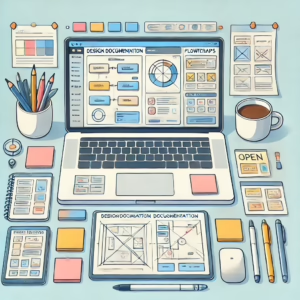Ever spent hours crafting the perfect UI, only to have it implemented completely differently? Or maybe you’ve seen your design system slowly crumble as new features get added without a clear reference? If you’re nodding along, you’ve run into a common product design problem—lack of proper design documentation.
In product design, documentation is really important. It’s what keeps the user experience consistent, helps developers bring your ideas to life correctly, and allows your team (present and future) to understand the why behind every pixel.
In this blog, we’ll walk you through exactly what design documentation is, why it matters in the world of digital products, and how you can create documentation that actually helps, not just collects dust in your Google Drive.

What Is Design Documentation?
Design documentation is much more than a boring report—it’s the written record of all the key decisions, guidelines, research, and iterations that go into building a product. Think of it as your project’s instruction manual; it tells every team member (from designers to developers to project managers) exactly what was done, why it was done, and how to carry that vision forward.
Key Components
A well-rounded design document typically includes:
- User Personas & Journeys: Who are you designing for, and what paths do they follow?
- Wireframes, Mockups & Prototypes: Visual representations of your design ideas.
- Style Guides & Design Systems: Reusable components, color palettes, typography rules, and layout guidelines.
- Accessibility Guidelines: Ensuring your design works for everyone.
- Implementation Details: How your design translates into code.
- Project Deadlines & Milestones: Keeping the project on schedule.
By covering these elements, design documentation serves as the “single source of truth” that guides your team’s efforts and preserves the rationale behind every decision.
Why Does Design Documentation Matter?
Without design documentation, your team might end up like a group of cooks trying to follow different recipes in the same kitchen. Here’s why a solid design document is essential:
1. Consistency & Clarity
Imagine every team member using their own version of what a “primary button” should look like. Chaos, right? Design documentation locks down your design language, ensuring that everyone works from the same playbook. It keeps your product’s look and feel uniform, avoiding those jarring inconsistencies that confuse users.
2. Smooth Team Communication & Collaboration
Design documentation acts as a reliable reference that everyone can consult. Whether you’re onboarding a new designer or handing over the project to developers, clear documentation cuts down on repetitive explanations. It’s like having a well-organized FAQ that everyone can refer to—saving time and reducing frustration.
Also read: Design to Development: How to Make a Smooth Design Handoff
3. Efficiency & Future-Proofing
When you document the “why” behind your decisions, you’re not just planning for today. You’re also setting up a roadmap for future iterations. If you or a new team member need to revisit the project months later, your design document will provide the context needed to make informed updates without starting from scratch.
4. A Historical Record of Decisions
Design documentation serves as a diary of your design journey. It captures what worked, what didn’t, and why certain choices were made. This historical reference is invaluable for learning from past mistakes and ensuring that the same errors aren’t repeated.

Types of Design Documentation
Design documentation comes in many types, each serving a unique purpose. Here are some common types you might encounter (or create):
- Requirements Documents:
These cover the functional and non-functional requirements of your software, including user stories and use cases. They lay the foundation for what needs to be built. - Architecture Documents:
Offering a high-level overview, these documents describe the overall structure of the software system—its modules, layers, and interfaces. - Source Code Documents:
Aimed at developers, these include code snippets and technical notes that explain how parts of the system work. - User Documents:
Manuals, FAQs, and tutorials that help end users understand and interact with the product. - Test Documents:
Detailed test plans, strategies, and checklists to ensure your design works as intended and meets quality standards.
Best Practices for Creating Design Documentation
Ready to create documentation that doesn’t just sit on a shelf gathering digital dust? Follow these best practices:
Start with a Summary
Kick off your document with a brief summary or executive overview. This “inverted pyramid” approach highlights the most critical decisions and goals right at the top, making it easy for busy stakeholders to grasp the essentials.
Know Your Audience
Tailor your document’s language and level of detail to the needs of its readers. Whether they’re designers, developers, or non-technical stakeholders, ensure the document is clear and accessible to everyone.
Keep It Clear & Concise
Avoid overly technical jargon where possible. Use plain language, bullet points, numbered lists, and plenty of visual aids—charts, diagrams, and annotated screenshots are your friends!
Maintain a Single Source of Truth
Centralize your documentation on a cloud-based platform like Notion, Google Docs, or Confluence. This ensures everyone always has access to the latest version, reducing confusion and version-control issues.
Encourage Collaboration
Invite feedback from your team. Whether through in-document comments or regular review meetings, collaboration makes your documentation richer and more accurate.
Regularly Update & Audit
Design documentation isn’t a one-and-done task. Schedule periodic reviews to update the content as your project evolves. This keeps the document relevant and reliable.
How to Write a Design Document: A Step-by-Step Guide
Follow these steps to create a design document that’s both comprehensive and easy to use:
Step 1: Define the Purpose & Scope
Before you write anything, clarify what your document will cover and why. What decisions are you documenting? What goals are you trying to achieve? Write these down to set a clear direction.
Step 2: Gather All Necessary Information
Collect your user research, previous iterations, style guides, and any design decisions that have already been made. Having all this information at hand will help you create a more complete document.
Step 3: Outline the Structure
Create an outline with clearly defined sections:
- Introduction & Purpose
- Problem Statement & Goals
- Design Decisions & Rationale
- Alternatives Considered
- Implementation Details
- Testing & Validation
- Timeline & Deliverables
- Appendices (Glossary, References, etc.)
Step 4: Write in a User-Friendly Tone
Use simple, conversational language. Remember: your document is for your team, not a scholarly journal. Keep sentences short, use bullet points for clarity, and add friendly comments where appropriate.
Step 5: Incorporate Visuals & Examples
Visual aids can make complex ideas much easier to understand. Use annotated diagrams, screenshots, and sample user flows to illustrate your points.
Step 6: Collaborate and Gather Feedback
Share your draft with the team. Encourage them to ask questions and suggest improvements. This collaborative process will help refine the document and ensure nothing important is missed.
Step 7: Finalize and Publish
Once you’ve addressed feedback, finalize the document and publish it on your chosen platform. Make sure it’s accessible to everyone involved in the project, and don’t forget to add version control to keep track of updates.
Sample Format & Template Overview
Here’s a quick sample format you can follow:
- Title & Team Members:
- Document Title, Date, and List of Contributors
- Document Title, Date, and List of Contributors
- Introduction:
- Purpose of the Document, Brief Overview of the Project
- Purpose of the Document, Brief Overview of the Project
- Problem Statement & Goals:
- What challenges are being addressed? What are the project’s goals?
- What challenges are being addressed? What are the project’s goals?
- Detailed Design Decisions & Rationale:
- Explain each decision and why it was made. Include alternatives if relevant.
- Explain each decision and why it was made. Include alternatives if relevant.
- Implementation & Testing:
- Outline how the design will be implemented and how it will be tested.
- Outline how the design will be implemented and how it will be tested.
- Timeline & Deliverables:
- Key milestones, deadlines, and expected outcomes.
- Key milestones, deadlines, and expected outcomes.
- Appendices:
- Glossary, References, and any additional notes.
- Glossary, References, and any additional notes.
Popular tools for creating and sharing these documents include Figma, Notion, Google Docs, and Confluence.
Future Trends in Design Documentation
Looking ahead, design documentation is set to become even more dynamic and integrated into the design process. Here are a few trends to watch:
- Automation & “Docs as Code”:
Version-controlled, automated documentation systems (similar to your code repository) that update in real time as design changes occur. - Interactive & Living Documentation:
Documentation that evolves with your product, with interactive elements and real-time collaboration features. - Enhanced Accessibility:
More focus on making documentation accessible to everyone, ensuring that it can be easily read and understood by all team members.
Conclusion
Design documentation might not be the flashiest part of your workflow, but it’s an absolute must-have for keeping your team aligned, your projects on track, and your design decisions clear.
By documenting the “why” and “how” behind your designs, you build a resource that not only streamlines communication but also paves the way for future improvements.
Ready to transform your design process? Start small, keep it clear, and don’t be afraid to iterate, just like your designs.
